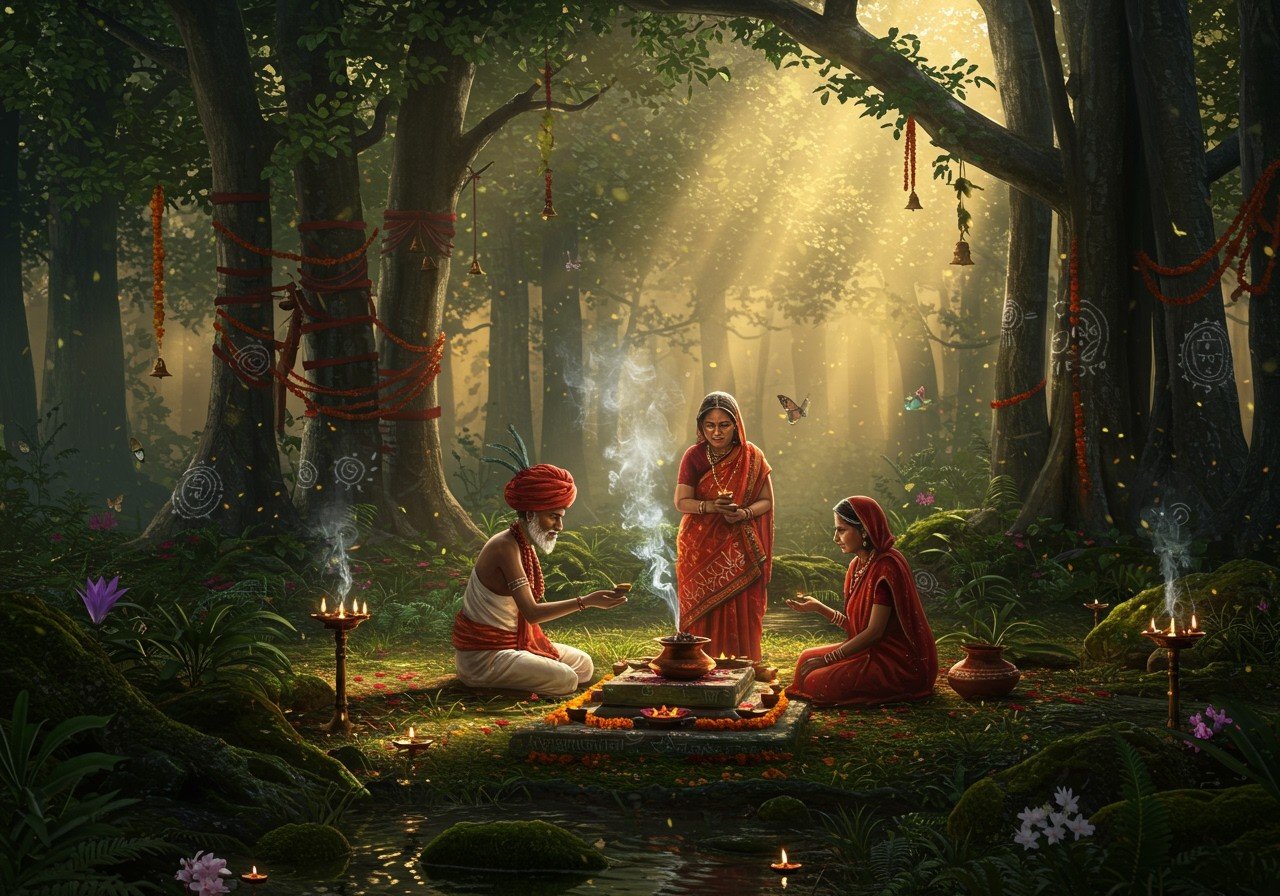
In the heart of India, tribal communities maintain a sacred bond with nature, expressed through rituals and customs passed down for generations. These traditions reflect a deep respect for the environment and contribute to ecological balance. Explore the ceremonies that showcase the tribes’ connection to the natural world and the vital role of sacred groves in their beliefs.
Understanding Sacred Groves
Sacred groves are forest patches protected by tribal communities due to their religious significance. These areas are crucial for biodiversity conservation, often sheltering rare plants and animals. Examples include the Khasi sacred forests in Meghalaya and Devarakadu in Karnataka. These groves are intertwined with traditional rituals, taboos, and conservation methods that maintain their sanctity. They also serve as repositories of unique flora and fauna, contributing to the overall health of the ecosystem.
Cultural heritage and mythology often surround these sacred spaces, with stories highlighting their importance in tribal identity. Spiritual leaders, or shamans, play a key role in upholding these traditions and conducting rituals. This ensures the community’s spiritual well-being and the continuation of ancient practices. The stories emphasize the connection between the tribe, the land, and the spiritual world, reinforcing the importance of preserving these natural spaces.
Tribal religious practices are diverse and deeply connected to nature. For tribes like the Santhal and Gond, nature worship is integral to daily life. Natural elements—water, fire, and trees—are central to their ceremonies. For instance, the Baiga’s annual festival honors the forest goddess, highlighting their bond with nature. Despite modernization, many communities strive to maintain these traditions. This includes teaching younger generations about the significance of these customs and the importance of their continuation.
Nature holds a special place in tribal religions, revered as a living entity with spiritual power. Mountains, rivers, and animals are seen as divine. Rituals and offerings appease deities believed to reside within these elements. This belief system promotes environmental ethics, advocating for sustainable living and respect for all life forms. It fosters a sense of responsibility for the environment and its preservation.
Unique tribal rituals demonstrate this profound environmental connection. The Bison Horn Maria’s dance in Chhattisgarh celebrates the harvest and honors the earth’s bounty. The Oraon tribe’s Navakhana ritual involves offering new grain to ancestors and deities, seeking blessings for future harvests. The Hornbill Festival among Naga tribes showcases cultural heritage and raises ecological awareness. The Bhil tribe’s elaborate rituals, using sacred symbols and chants, strengthen community bonds and cultural continuity. Each of these rituals reflects a deep understanding and respect for the natural cycles of life.
Preserving these sacred groves and rituals faces challenges from deforestation, urbanization, and land encroachment. Governmental and non-governmental organizations (NGOs) work to protect these cultural and ecological treasures. Community-led initiatives aim to revive traditional practices and safeguard sacred spaces. Balancing development and cultural preservation necessitates sustainable policies and responsible land management practices. Eco-tourism offers a potential avenue for promoting awareness and generating income for tribal communities.
Rituals and Beliefs
In India, sacred groves are more than just green spaces. They are sanctuaries where tribal communities honor local deities and ancestral spirits. Within these spaces, a profound belief exists: the divine dwells in specific trees and plants. Harming these sacred trees is believed to invite misfortune or even natural disasters. This belief system emphasizes the importance of respecting and protecting the natural world.
To express gratitude or seek blessings, tribes perform intricate rituals. These often involve animal sacrifices and offerings, including country liquor. Cultural expressions, like ritualistic dances and folk tales, enrich the community’s heritage within these groves. These ceremonies strengthen the community’s bond with the sacred grove and its spiritual significance.
Conservation Practices
Tribal communities view sacred groves as untouchable sanctuaries. Their religious beliefs drive them to protect these areas from human interference. Trees within the groves remain unharmed, and activities like hunting and logging are strictly prohibited. This respect extends even to fallen leaves and fruits, which are often left undisturbed. These practices are deeply rooted in the belief that the grove is a sacred dwelling place of the gods.
Such practices play a vital role in biodiversity preservation. Many groves shelter rare and endangered species, ensuring their survival. These areas act as genetic reservoirs, contributing to the long-term health and resilience of the surrounding ecosystems.
Examples of Rituals
Across India, unique rituals are associated with sacred groves. In Madhya Pradesh, the Pateliya community performs elaborate rituals for wish fulfillment, sometimes as costly as a wedding. In central and eastern India, Sarna followers hold marriage ceremonies under sacred trees like mango and bamboo. These ceremonies highlight the integral role of sacred trees in life cycle events.
During the Sarhul festival, the sal tree receives offerings of rice, flowers, and fruits as a mark of reverence. The Karam festival sees Sarna tribals worship the sacred karam tree for better crop production. The Faggu festival involves gathering dry wood and leaves, reducing wildfire risks. Each of these festivals demonstrates the deep connection between tribal communities and the natural world.
Significance
Sacred groves are crucial for flora and fauna diversity. They prevent soil erosion and preserve medicinal plants. India is estimated to have over 100,000 sacred groves, which are vital to the socio-cultural fabric of tribal communities. They represent an age-old approach to natural resource management. The groves act as natural pharmacies, safeguarding traditional medicinal knowledge.
These tribes, with their deep respect for nature, offer a model for sustainable living. Their traditions remind us of the crucial harmony between humans and the natural world. They offer valuable lessons on how to live in balance with the environment.
How Poojn.in Supports Sacred Grove Rituals and Tribal Traditions
Poojn.in, India’s largest cultural goods and services store, offers essential items for sacred grove rituals and tribal ceremonies. The platform makes traditional puja items accessible, enabling the continuation of ancient practices in modern settings. By providing these items, Poojn.in supports the preservation of cultural heritage and spiritual practices.
For sacred grove rituals, Poojn.in provides:
- Pure copper kalash for water offerings, essential for many purification and offering rituals. The copper is believed to have purifying properties, enhancing the spiritual significance of the offerings.
- Natural cotton wicks for diya lighting, symbolizing the dispelling of darkness and ignorance. The natural cotton ensures a clean and pure flame, ideal for sacred ceremonies.
- Organic kumkum and haldi for markings, used in various rituals and ceremonies to signify auspiciousness and blessings. The organic nature of these items aligns with the reverence for natural elements.
- Traditional bell metal items for ceremonies, creating sacred sounds that resonate within the grove. These items are often handcrafted, carrying cultural significance and artistic value.
- Pure ghee for sacred fire rituals, an essential offering in many ceremonies. The purity of the ghee is crucial for maintaining the sanctity of the ritual.
Poojn.in also offers specific items used by many tribal communities in their worship of sacred groves:
- Coconuts for offerings, a symbol of wholeness and abundance, often broken open as an offering to the deities. The coconut water and flesh are considered sacred offerings.
- Camphor for aarti, used to create a sacred flame and purify the atmosphere during prayers. The aroma of burning camphor is believed to have cleansing properties.
- Pure cotton thread for ritual bindings, used in various ceremonies to symbolize connections and create sacred boundaries. The purity of the cotton is essential for maintaining the integrity of the ritual.
- Brass and copper vessels for ceremonial use, adding to the aesthetic and spiritual value of the rituals. These vessels are often intricately designed and passed down through generations.
- Natural incense and dhoop, creating a fragrant atmosphere during ceremonies, enhancing the spiritual experience. The natural ingredients are believed to have purifying and elevating properties.
Poojn.in verifies the authenticity of these items through direct sourcing from trusted suppliers. Each product includes detailed information about its ritual significance and proper usage. With nationwide delivery, Poojn.in makes these essential items readily available, aiding in the preservation of these crucial traditions, even in remote areas.
Note: Product availability may vary. Please check the website for current stock and pricing.
Hawan Samagri |
Cotton Wicks |
Kumkum
Embracing the Wisdom of Sacred Groves
Journeying through the sacred groves and rituals of tribal India reveals a profound connection between communities and nature. These groves are not merely spiritual havens; they demonstrate how tradition and conservation can intertwine. By safeguarding these sanctuaries, tribal communities protect their cultural heritage and the environment. This holistic approach to preservation highlights the interconnectedness of culture and ecology.
In our fast-paced world, the wisdom of sacred groves offers a valuable lesson: living in harmony with nature. By honoring these age-old practices, we appreciate the delicate balance sustaining our planet. Through rituals, conservation, and community spirit, sacred groves teach respect, gratitude, and unity with the earth. This wisdom emphasizes the importance of sustainable living and intergenerational responsibility.
Let’s embrace this knowledge and work together to preserve these sacred spaces for future generations. This not only protects our environment but also celebrates India’s rich tapestry of tribal traditions. By supporting these communities and their practices, we contribute to a more sustainable and culturally vibrant future.


